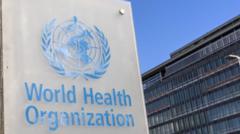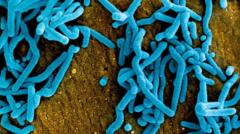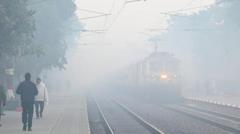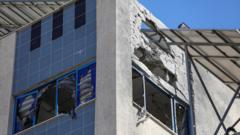The dense smog choking Delhi has led authorities to shut down all primary schools, shifting classes online until further notice as hazardous air quality persists.
Delhi Closes All Primary Schools Amid Intensifying Smog Crisis
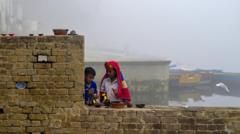
Delhi Closes All Primary Schools Amid Intensifying Smog Crisis
Delhi's air pollution levels reach alarming heights, prompting school closures and health warnings
Delhi officials have announced the closure of all primary schools in the city due to dangerously high pollution levels that pose significant health risks. Chief Minister Atishi Marlena Singh shared the decision on X, citing worsening conditions as a thick layer of smog envelops the Indian capital.
Recent data shows that pollution levels in Delhi and adjacent areas are far beyond safe limits, with fine particulate matter exceeding 50 times the World Health Organization's (WHO) safety threshold. On Thursday, the air registered an alarming average of 254 PM 2.5 particles per cubic meter, while the recommended safe limit is a mere 15. The crisis escalates annually as winter temperatures drop, exacerbating factors like vehicle emissions, agricultural burning, and minimal wind.
Furthermore, PM 10 levels also reached critical averages of 495, which is over ten times the permissible daily amount. Reports of eye irritations and ongoing respiratory issues reflect the severe impact on residents' health, with a notable study in The Lancet attributing 7.2% of daily deaths in the city to fine particulate pollution.
Neighboring cities like Gurugram and Noida are experiencing similar hazardous conditions, echoing concerns in northern Indian cities like Chandigarh. Although officials expect a potential decline in pollution levels soon, they will likely remain at unhealthy thresholds.
As part of efforts to mitigate the crisis, the Delhi government has implemented measures that include dust suppression spraying on roads and a prohibition on non-essential construction activities. Despite these initiatives, critics argue that many strategies have fallen short of effectively tackling the pollution problem.
Satellite imagery from NASA has portrayed the smog cloud as a significant environmental issue visible from space, extending over north India and reaching into Pakistan. This month, Lahore's air quality also deteriorated to the extent that schools had to be temporarily shuttered due to pollution concerns.
As the epidemic of air pollution unfolds, residents and experts alike remain wary of its growing health implications that threaten the large population of Delhi, which exceeds 33 million.
Recent data shows that pollution levels in Delhi and adjacent areas are far beyond safe limits, with fine particulate matter exceeding 50 times the World Health Organization's (WHO) safety threshold. On Thursday, the air registered an alarming average of 254 PM 2.5 particles per cubic meter, while the recommended safe limit is a mere 15. The crisis escalates annually as winter temperatures drop, exacerbating factors like vehicle emissions, agricultural burning, and minimal wind.
Furthermore, PM 10 levels also reached critical averages of 495, which is over ten times the permissible daily amount. Reports of eye irritations and ongoing respiratory issues reflect the severe impact on residents' health, with a notable study in The Lancet attributing 7.2% of daily deaths in the city to fine particulate pollution.
Neighboring cities like Gurugram and Noida are experiencing similar hazardous conditions, echoing concerns in northern Indian cities like Chandigarh. Although officials expect a potential decline in pollution levels soon, they will likely remain at unhealthy thresholds.
As part of efforts to mitigate the crisis, the Delhi government has implemented measures that include dust suppression spraying on roads and a prohibition on non-essential construction activities. Despite these initiatives, critics argue that many strategies have fallen short of effectively tackling the pollution problem.
Satellite imagery from NASA has portrayed the smog cloud as a significant environmental issue visible from space, extending over north India and reaching into Pakistan. This month, Lahore's air quality also deteriorated to the extent that schools had to be temporarily shuttered due to pollution concerns.
As the epidemic of air pollution unfolds, residents and experts alike remain wary of its growing health implications that threaten the large population of Delhi, which exceeds 33 million.




